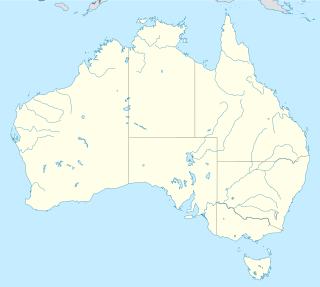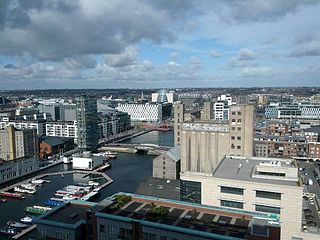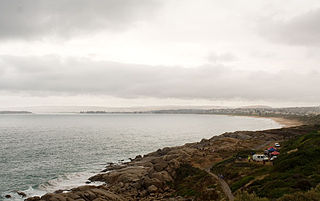The Kaurna people are a group of Indigenous Australians whose traditional lands include the Adelaide Plains of South Australia. Pronunciation of the word "Kaurna" varies slightly by the background and origin of the speaker; the most common is English, sometimes, native [ɡ̊auɲa] or, less often,. They were known as the Adelaide tribe by the early settlers. Kaurna culture and language were almost completely destroyed within a few decades of the European settlement of South Australia in 1836. However, extensive documentation by early missionaries and other researchers has enabled a modern revival of both language and culture.

Lieutenant-Colonel George Gawler, KH, was the second Governor of South Australia: from 17 October 1838 until 15 May 1841.

The Adelaide Plains is a plain in South Australia lying between the coast on the west and the Mount Lofty Ranges on the east. The southernmost tip of the plain is in the southern seaside suburbs of Adelaide around Brighton at the foot of the O'Halloran Hill escarpment with the south Hummocks Range and Wakefield River roughly approximating the northern boundary.
The Aboriginal people of East Gippsland, Victoria, Australia, known as the Gunai/Kurnai people, fought against the European invasion of their land. The technical superiority of the Europeans' weapons gave the Europeans an absolute advantage. At least 300 people were murdered, but other figures estimate up to 1,000; however, it is extremely difficult to be certain about the real death toll as so few records still exist or were even made at the time. Diseases introduced from the 1820s by European sealers and whalers also caused a rapid decline in Aboriginal numbers. The following list was compiled from such things as letters and diaries.
The following lists events that happened during 1840 in Australia.

Matthew Moorhouse was a mass murderer, an English pioneer in Australia, pastoralist, politician, and Protector of Aborigines in South Australia. He led the Rufus River massacre, where he and his men murdered 30-40 Maraura men, women and children.
Peacock & Son was a tanning and wool-brokering business in the early days of South Australia. Three members of the family were notable public figures: William Peacock was a successful businessman and one of the colony's first parliamentarians. His eldest son Joseph Peacock carried on the family business and was a member of parliament. His youngest son Caleb Peacock was a member of parliament and Mayor of Adelaide from 1875 to 1877, the first such born in the Colony.

The Australian frontier wars is a term applied by some historians to violent conflicts between Indigenous Australians and white settlers during the British colonisation of Australia. The first fighting took place several months after the landing of the First Fleet in January 1788 and the last clashes occurred in the early 20th century, as late as 1934. A minimum of 40,000 Indigenous Australians and between 2,000 and 2,500 settlers died in the wars. However, recent scholarship on the frontier wars in what is now the state of Queensland indicates that Indigenous fatalities may have been significantly higher. Indeed, while battles and massacres occurred in a number of locations across Australia, they were particularly bloody in Queensland, owing to its comparatively larger pre-contact Indigenous population.

Henry Inman (1816–1895) was an English cavalry officer, pioneer of South Australia, founder and first commander of the South Australia Police, overlander and Anglican clergyman.
Water Witch was a single-masted vessel rigged as a cutter built during 1835 in Van Diemen's Land and sunk in 1842 whilst moored in the River Murray at Moorundie, south of Blanchetown in South Australia (SA). Her wreck site was discovered in 1982 and received statutory protection as a historic shipwreck in 1983. The wreck site was the subject of an underwater survey in March 1984. She is notable for being the first European vessel to enter the River Murray via its mouth, her role in the charting of the lower reaches of the River Murray including Lake Alexandrina whilst under the command of William Pullen and her association with Edward John Eyre.
The Rufus River Massacre was a massacre of Aboriginals that took place in 1841 along the Rufus River near Wentworth, Australia. It was the result of six months of guerrilla warfare by the local Aboriginal people (Maraura), who blocked an overlander route through their land. The original cause of much of the trouble with the Aboriginal groups was the Europeans engaging in sexual relations with the women without giving the food and clothing promised first. That initiated an escalating cycle of conflicts, which eventually included the Aboriginal groups stealing thousands of European sheep.
James Rigby Beevor (1811–1849) was a pioneer colonist and pastoralist of South Australia and a murder victim of the Australian frontier wars. Mount Beevor in South Australia is named after him.
Rapid was the brig that brought William Light's surveying party to the new colony of South Australia. She was wrecked in 1841.

James Collins Hawker (1821-1901) was an English-born explorer, surveyor, diarist and pastoralist of South Australia, aide-de-camp to Governor George Gawler, and subsequently Comptroller of H.M. Customs at Port Adelaide.
The Aboriginal People of South Australia are the aboriginal people who lived in South Australia prior to European colonization of Australia: their descendants and their ancestors. There is much debate and controversy in identifying the names, territorial boundaries, and language groups of the Aboriginal peoples of South Australia. Post-colonial history is also dogged by poor record keeping and deliberate obfuscation. This article should be taken as a rough guide only about the Aboriginal People.

The Avenue Range Station massacre was the murder of a group of Aboriginal Australians by white settlers during the Australian frontier wars. It occurred in about September 1848 at Avenue Range, a sheep station in the southeast of the Colony of South Australia.
Dundalli was an Aboriginal lawman who figured prominently in accounts of conflict between European settlers and indigenous aboriginal peoples in the area of Brisbane in South East Queensland. Traditionally described as a murderer, savage and terrorist, he is now thought variously to have been a guerilla leader or to have coordinated a decade-long resistance to white colonization the area. He was hung publicly in Brisbane in 1855 by order of the Sheriff of New South Wales.
Governor Gawler was built in 1840. This made her the first sailing vessel built in South Australia. She traded between Port Lincoln and Port Adelaide, but also carried cargo and passengers to Melbourne and Hobart Town, including soldiers, police, criminals, an executioner, as well as numerous civilians. When she wrecked in 1847, she was the first South Australian ship to be wrecked.

















